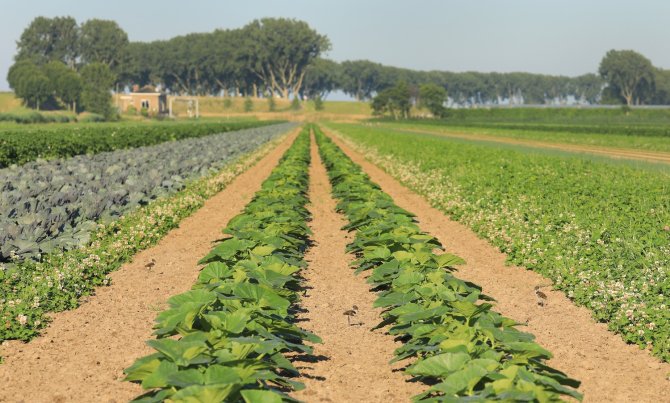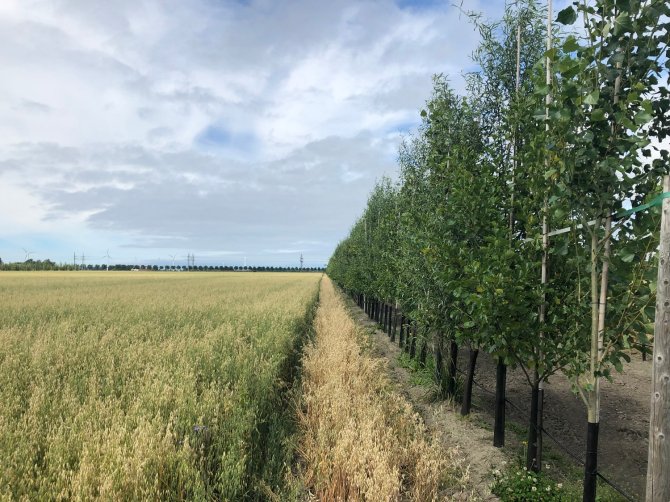
Crop diversity
Crop diversity means a field features different crops in sequence, side by side, or intermingled. It is the opposite of a monoculture, which has only a single crop type per plot. Crop diversity benefits nature and farmers alike, which is why Wageningen University & Research is investigating opportunities to create more crop diversity in agriculture.
Crop diversity as an alternative to monoculture
Large plots with a single crop type each are a labour-efficient way of producing food. As such, the agricultural sector in the Netherlands and many other European countries is fully tailored to monocultures, and not without reason. In the second half of the 20th century, the demand for affordable food increased, and the agricultural sector adapted accordingly.
However, monocultures have their disadvantages. The system requires large amounts of artificial fertiliser and heavy machinery to guarantee high yields. This negatively impacts biodiversity both above the surface and underground. On top of that, the system is vulnerable, since farmers depend on only a limited number of buyers.

Forms of crop diversity
There are different ways for farmers to apply crop diversity. Roughly, there are three options: crop diversity in space or time, or genetic diversity. Almost all arable farmers use some form of crop rotation over the years, but short rotation further increases crop diversity. Farmers can also combine different forms, such as strip cropping with crop rotation, or mixed intercropping.
Crop diversity in space
- Alley cropping: trees or bushes are combined with the cultivation of (annual) crops or pasture and livestock farming.
- Strip cropping: different crops are cultivated in adjacent strips of soil, each managed differently.
- Pixel cropping: various crops are intermingled, each with their own management approach. This method is only applied to a limited extent at the moment due to mechanisation challenges.
Crop diversity in time
- Crop rotation: alternating different crops on the same plot and changing them annually or after a growing season. For example, a farmer could plant green manure after a crop.
- Relay cropping: multiple crops on the same plot, but with different harvest times. As a result, the plot will never be empty.
Genetic crop diversity
- Food forests: a food production system designed by humans, inspired by the layout of a natural forest.
- Mixed cropping: the intermingled cultivation and simultaneous harvesting of multiple crops, like field beans and wheat.
- Variety mixtures: Intermingling multiple varieties of the same crop, such as cereals.
- Composite cross populations (CCPs): a mix of genetically divergent individuals, crossbred from different varieties of the same crop.
Potential benefits of crop diversity for nature and farmers
Cultivating multiple different crops in sequence, side by side, or intermingled contributes to biodiversity. This approach offers plenty of shelter to insects, even after harvest. Birds and other animals similarly benefit. The soil quality can be maintained thanks to more extensive crop rotation and the opportunity to use green manures. All of the above combined will lead to a richer variety of life in the soil.
As a result of all these benefits for nature, the crops are less susceptible to harm. Diseases won’t be transmitted as easily as they are in monocultures due to the natural barriers formed by the other crop types. On top of that, an abundance of natural enemies will reduce the problem of pests and the lack of fallow soil will help prevent weeds.
In short, arable production systems and ecosystems are no distinct fields, but make up a unified whole. As such, this approach is also known as nature-inclusive agriculture.

Do farmers profit from increased crop diversity?
Higher crop diversity can definitely be profitable for farmers, though this depends on a variety of factors, such as the choice of crop combinations, harvest times, strip width and the efficiency of the machines the farmer already owns. Higher disease resistance may also make a system with crop diversity more profitable. This does depend on the market and the availability of subsidies, however. Among other research, WUR performed an economic study into strip cropping.